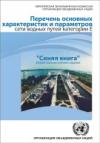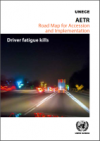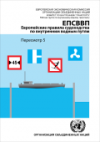Publications
Displaying Results 61 - 80 of 215
- English
The GHS addresses classification of chemicals by types of hazard and proposes harmonized hazard communication elements, including labels and safety data sheets. It aims at ensuring that information on physical hazards and toxicity from chemicals be available in order to enhance the protection of human health and the environment during the handling, transport and use of these chemicals.The GHS
- English
These recommendations have been developed in the light of technical progress, the advent of new substances and materials, the exigencies of modern transport systems and, above all, the requirement to ensure the safety of people, property and the environment. They are addressed to governments and international organisations concerned with the regulation of the transport of dangerous goods. The
- English
The objective of the Inventory of Main Standards and Parameters of the E Waterway Network (“Blue Book”) is to establish an inventory of existing and envisaged standards and parameters of E waterways and ports in Europe and to show, on an internationally comparable basis, the current inland navigation infrastructure parameters in Europe as compared to the minimum standards and parameters
- Pусский
Цель «Синей книги» - предоставить перечень существующих и планируемых характеристик и параметров водных путей и портов категории E в Европе и показать, на международно-сопоставимой основе, нынешние параметры инфраструктуры внутренних водных путей по сравнению с минимальными характеристиками и параметрами, предписанными в Европейском соглашении о важнейших внутренних водныхпутях международного
- Français
Le Livre bleu dresse un inventaire des normes et paramètres actuels et envisagés des voies navigables et ports E en Europe, régulièrement mis à jour par la Division des transports de la CEE-ONU, et présente, sur une base internationale comparable, les paramètres d'infrastructure actuels de la navigation intérieure en Europe par rapport à ceux des normes et paramètres minimaux prescrits dans l'
- English
European Agreement concerning the Work of Crews of Vehicles Engaged in International Road Transport (AETR)Road Map for Accession and ImplementationErratum: on page 25, the Russian Federation is erroneously listed as one of the countries applying the AETR Agreement domestically. The authors regret this error.
- English
The European Agreement concerning the International Carriage of Dangerous Goods by Inland Waterways (ADN) done at Geneva on 26 May 2000 under the auspices of the United Nations Economic Commission for Europe (UNECE) and the Central Commission for Navigation on the Rhine (CCNR) has been in force since February 2008. The Agreement currently has eighteen Contracting Parties.The Regulations
- English
Adopted on 30 September 1957 in Geneva under the auspices of the United Nations Economic Commission for Europe (UNECE), the ADR entered into force on 29 January 1968.This authoritative Agreement is intended to increase the safety of international transport of dangerous goods by road. Its Annexes A and B contain the technical requirements for road transport, i.e. the conditions under which
- English
ST/SG/AC.10/11/Rev.6Sales No. E.15.VIII.3ISBN 978-92-1-139155-8Price: US$ 125Languages: E, F, S (A, C, R forthcoming)How to order this publication?This publication is also available online for free (download).The Manual of Tests and Criteria contains criteria, test methods and procedures to be used for classification of
- English
The GHS addresses classification of chemicals by types of hazard and proposes harmonized hazard communication elements, including labels and safety data sheets. It aims at ensuring that information on physical hazards and toxicity from chemicals be available in order to enhance the protection of human health and the environment during the handling, transport and use of these chemicals.The GHS
- English
These recommendations have been developed in the light of technical progress, the advent of new substances and materials, the exigencies of modern transport systems and, above all, the requirement to ensure the safety of people, property and the environment. They are addressed to governments and international organisations concerned with the regulation of the transport of dangerous goods. The
- English
CEVNI contains the core rules applicable to the traffic on inland waterways in the UNECE region such as marks and draught scales on vessels, visual signals on vessels, sound signals and radiotelephony, waterway signs and markings, rules of the road, berthing rules, signalling and reporting requirements as well as prevention of pollution of water and disposal of waste. These harmonized
- English
The European Agreement concerning the International Carriage of Dangerous Goods by Inland Waterways (ADN) done at Geneva on 26 May 2000 under the auspices of the United Nations Economic Commission for Europe (UNECE) and the Central Commission for Navigation on the Rhine (CCNR) has been in force since February 2008. The Agreement currently has eighteen Contracting Parties.The Regulations
- English
Adopted on 30 September 1957 in Geneva under the auspices of the United Nations Economic Commission for Europe (UNECE), the ADR entered into force on 29 January 1968. This authoritative Agreement is intended to increase the safety of international transport of dangerous goods by road. Its Annexes A and B contain the technical requirements for road transport, i.e. the conditions under
- English
The Manual of Tests and Criteria contains criteria, test methods and procedures to be used for classification of dangerous goods according to the provisions of Parts 2 and 3 of the United Nations Recommendations on the Transport of Dangerous Goods, Model Regulations, as well as of chemicals presenting physical hazards according to the Globally Harmonized System of Classification and Labelling
- English
These recommendations have been developed in the light of technical progress, the advent of new substances and materials, the exigencies of modern transport systems and, above all, the requirement to ensure the safety of people, property and the environment. They are addressed to governments and international organisations concerned with the regulation of the transport of dangerous goods. The
- English
The GHS addresses classification of chemicals by types of hazard and proposes harmonized hazard communication elements, including labels and safety data sheets. It aims at ensuring that information on physical hazards and toxicity from chemicals be available in order to enhance the protection of human health and the environment during the handling, transport and use of these chemicals.The GHS
- Pусский
Content
The first section describes the TIR transit system, its coverage, objective and functioning and analyses possible future developments.
The second section contains the complete text of the TIR Convention.
The third section contains related resolutions and recommendations.
- Français
Content
The first section describes the TIR transit system, its coverage, objective and functioning and analyses possible future developments.
The second section contains the complete text of the TIR Convention.
The third section contains related resolutions and recommendations.
- العربية
Content
The first section describes the TIR transit system, its coverage, objective and functioning and analyses possible future developments.
The second section contains the complete text of the TIR Convention.
The third section contains related resolutions and recommendations.















